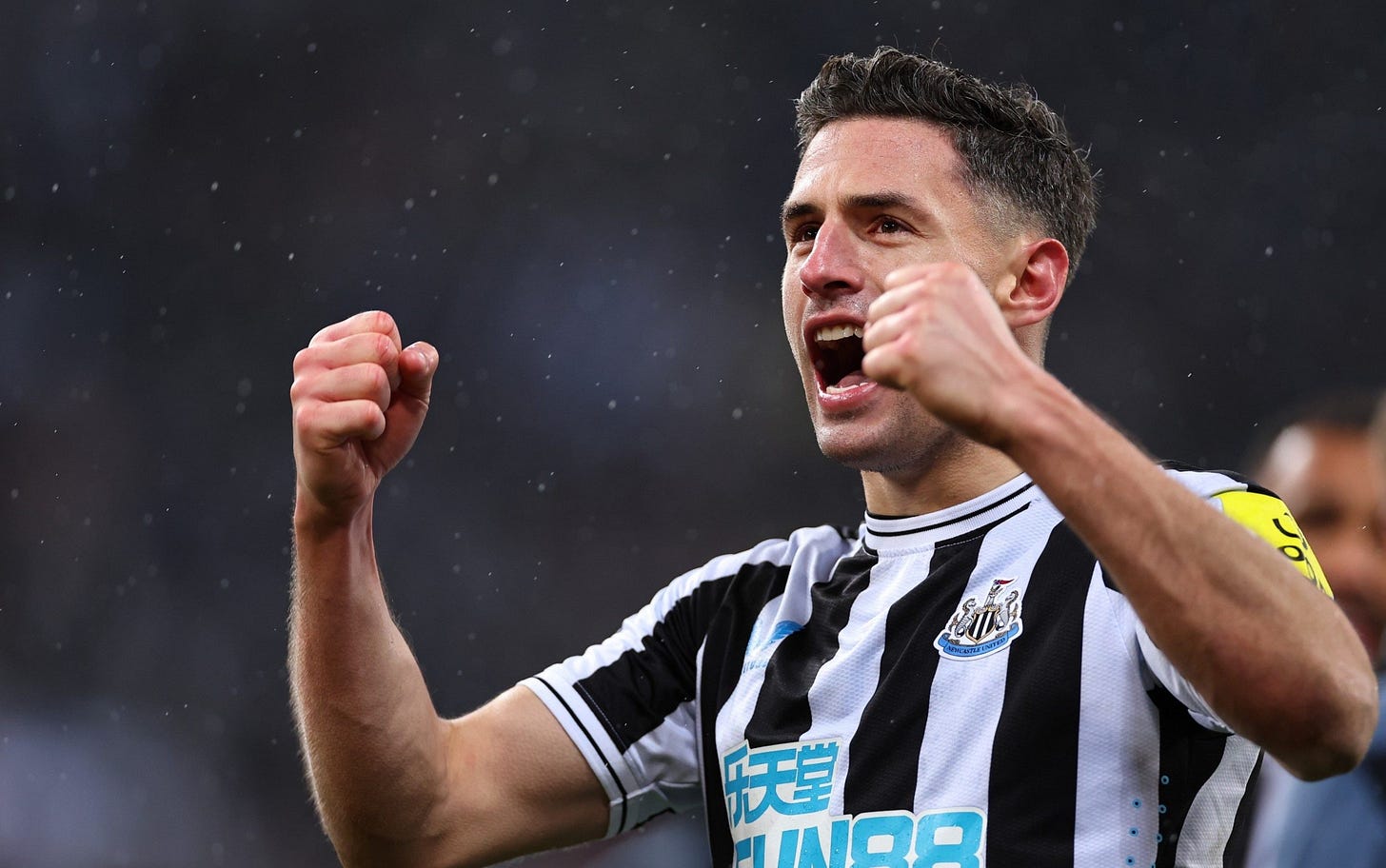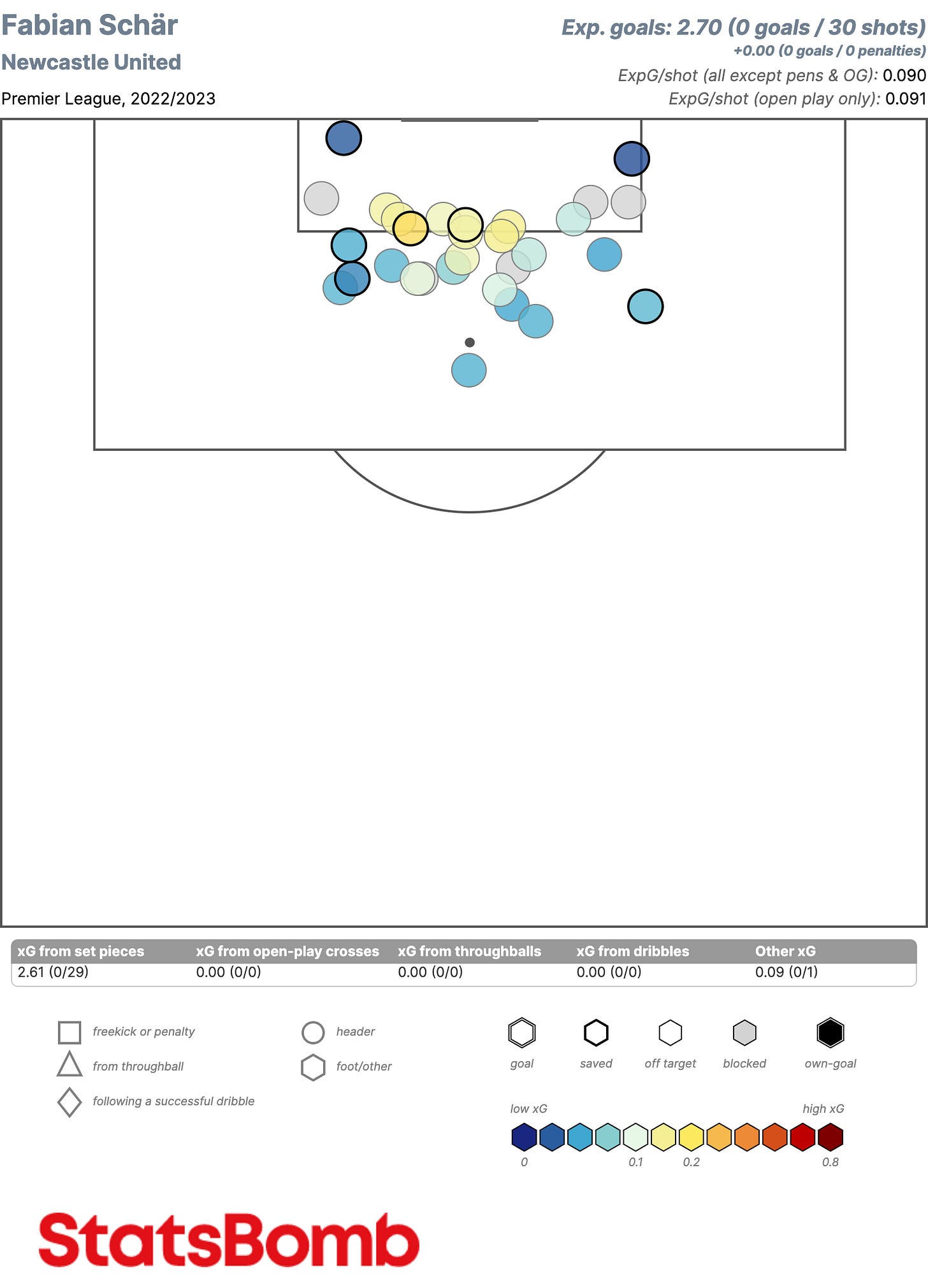That's Howe: The revival of Fabian Schar's Newcastle United Career
The first in a series looking at the players Eddie Howe's coaching has revived or improved.
Whenever Newcastle United’s post-takeover success is discussed on X (formerly known as Twitter), you'll invariably find a comment stating something like: “Well, when you can spend whatever you like, it’s bound to be easy,” especially from fans or journalists who support other teams.
While some make these comments to bait fans, a significant number of football followers genuinely believe that success in football boils down solely to having the most money. Although having deep pockets can be advantageous – both Man Utd and Chelsea have demonstrated that merely spending money has its limits – the right coach is an indispensable component of the success equation.
For Amanda Staveley and the rest of the board at St. James Park, the decision to appoint Eddie Howe as their first managerial choice has been foundational in transitioning from the brink of relegation to Champions League qualification within 18 months. In an era where Financial Fair Play (FFP) sets limits on club expenditures, maximizing the potential of existing players is crucial for achieving such remarkable progress.
As such, this newsletter will be the first in a series about Eddie Howe’s ability to improve players who were already at the club. In this newsletter, we’re focusing on Swiss international Centre Back, Fabian Schar.
Establishing a baseline
Before we dive into some visualisations, a word of caution. Centre Backs are one of the hardest positions on the pitch to evaluate using data alone - context matters. This is because most football data is predicated on what’s happening on the ball, where a centre-back’s quality is determined by off-the-ball qualities like positioning, awareness, body shape and spacing to other defenders.
However, advanced data models like On-Ball Value (OBV) use the previous action on the ball to measure the quality of players’ defensive actions to give us a clearer view of player performance without the need to watch hours and hours of footage. Now as a Newcastle United obsessive, I happened to have also watched hours and hours of games, so I can give you the best of both worlds here.
The Benitez & Bruce Eras
A good example of this is looking at the differences in performance under Schar’s first two Newcastle United bosses: Rafa Benitez 🔵 2018/19) and Steve Bruce ( 🔴 2019 until November 2021).
The results reflect the player’s overall qualities within the frameworks provided by both managers. Under both managers, Newcastle were fundamentally a counter-attacking team that often played with three centre backs affording Schar a little more flexibility in his role in possession as a ball progression threat alongside Jonjo Shelvey.
Under Benitez, the team was structured and organised helping Schar achieve better in-possession metrics. Under Bruce, Newcastle were more disorganised and the opportunities for Schar to increase his Defensive Action OBV weren’t in short supply.
Fundamentally though, there isn’t a huge difference here beyond some stylistic and statistical noise.
Performances under Howe in 22/23
Following the team’s escape from relegation in 21/22, Newcastle established a new high-pressing style with Schar forming a partnership alongside new signing Sven Botman as a right centre back as part of a back four in a 4-3-3 formation.
This tactical shift, a new defensive partner at the centre of defence and the addition of Kieran Trippier as a right-sided full-back reshaped Schar’s role within the team - which is reflected in his radar in two ways.
1.) In Possession
At a glance, you can see that Schar’s Passing OBV falls back under Howe which is expected as part of a back four where any mistakes on the ball would perhaps be more fatal than as part of a back three/five.
So instead of helping Shelvey punch the ball long, or through the lines at EVERY single opportunity, Schar’s new role required a lot more safety first balls “How many more?” I hear you ask… well it’s a bit mind-blowing.
Successful passes played by Schar:
22/23: 1393 - 32% forward with a 25.39m average pass length
20/21: 679 - 41% forward with a 30.03m average pass length
18/19: 680 - 35% forward with a 29.84m average pass length
Below you can see Schar’s expected passing (xPass) performance across all of last season. We can clearly see an above-expectation execution in easier and average passes but this is below par on the harder end of the spectrum.
As the 22/23 season wore on and Newcastle’s coaching staff added more dimensions to their attacking play, Schar’s use of the ball improved and he began to pick the right moments to push the ball down the field.
This came to a glorious head during the final few months of the season with a designed pattern of play that ended up in two goals. Whenever Schar had time to get his head up and pick a pass, Joelinton (when playing left wing) would make a run across from the right wing through to the central area behind the opposition’s defence.
Schar’s ability to see the pass and execute it perfectly led to goals at West Ham and in the drubbing of Spurs At St James’ Park, both of which you can see below.
This pattern was a variation on the right-to-left switch in play that had been visible throughout the first half of the same season, which itself was a ploy also used by Benitez (but not Bruce). Below is a simple count of completed passes from just inside the halfway line into the final third.
In 2023/24 so far, despite being moved around the Newcastle United defence to cover for the injured Sven Botman, Schar has now perfected his in-possession role with the ball and is passing above expectation no matter how difficult the pass.
That includes a particularly delicious ball in the build-up to this season’s win at home against Arsenal to Joelinton who had been moved to the left wing just moments earlier.
2.) Aerial duels
One area we see a dramatic improvement under Howe is in the number of balls he wins in the air. Under Benitez and Bruce, Schar’s aerial win % was a below-average 52-54%, in 22/23 this increased to 68.4%, so what’s happening?
Well, it has a lot to do with Schar’s supporting cast in defence. While not rapid across the ground, Sven Botman’s ability to read the game and anticipate where the danger is sees the Dutch international play a more covering role along the defensive line, freeing Schar to play more of a stopper role and aggressively attack balls on the ground in the air.
When coupled with the aerial power of Dan Burn and Sven Botman on the left side of the back four, opposition teams were almost forced to kick long towards the right side of Newcastle’s defence giving Schar a high number of opportunities to compete for balls with confidence that his defensive partner has the ability to cover the space he leaves.
You can see this dynamic playing out in the blue boxes marked out in the duo’s aerial duels from 22/23 in the image below.
The result of all those aerial wins was an increase in Schar’s overall ability to win the ball in the air. We can measure this beyond pure percentages or counts of headers won by using StatsBomb’s HOPS model.
HOPS essentially generates aerial ratings for players to estimate how likely they are to win an aerial duel. It does this over time using a chess-style rating system that rewards players more for beating aerially powerful Virgil van Dijk in the air than shorter players, like Raheem Sterling.
By looking at Schar’s rating since 2017, we can see the effect of Howe’s coaching. Schar is rated at 481 as well as he has done throughout the seven seasons, but still well below Botman (559), Burn (609) and Lascelles (592). While at least two of these teammates are on the pitch, Schar only has to deal with the third strongest aerial threat and is somewhat protected at defensive set-pieces.
One area where his relatively average ability in the air did show up last season, was in the attacking penalty area where - because of his ability in the air - Schar is often the final target of some of our set pieces. It is, however, one thing to win the ball in the air and quite another to direct it with enough force to get it beyond a Premier League goalkeeper. It is the main reason that Schar managed to get just 7 of 30 headed shots on target last season and failed to score any of them.
Performances so far in 23/24
So far this season, we’ve seen both of Schar’s passing and aerial duelling numbers return to their historic norms while his defending hitting his overall best levels since he’s been at Newcastle United.
It’ll be interesting to see how this evolves once Botman returns to the team and Schar is moved back to his normal position as a right-sided centre-back - or whether an injury to Dan Burn may expose him in the air from set pieces.
For now, it’s enough to simply enjoy the quality of his performances while he remains a fixture in the first team. At the age of 32, he’s likely to become a squad player rather than a central pillar of the defence over the next couple of seasons.
What remains clear is that finding a replacement that offers the same level of passing quality with the addition of speed AND being better in the air is not cheap nor easy. One of these qualities might need a compromise and I’m fascinated to see who Newcastle United eventually choose.














Great stuff, Kev! Schar has to arguably be the best value-for-money signing in NUFC history. Absolutely love him.